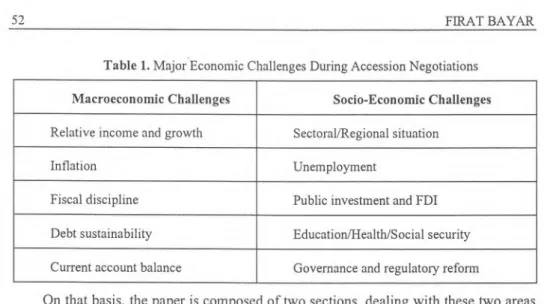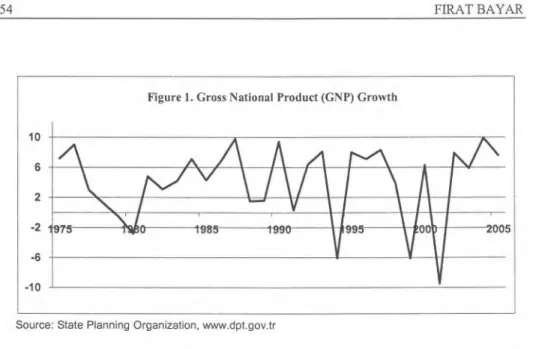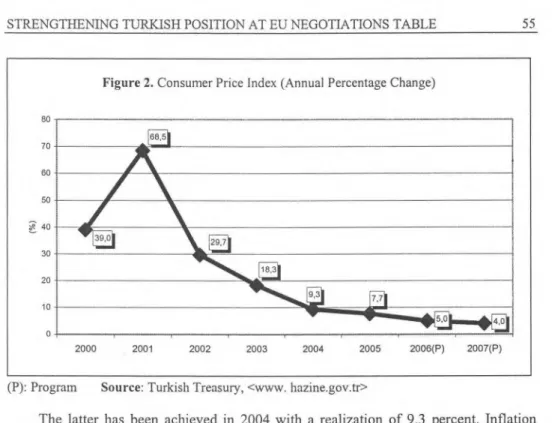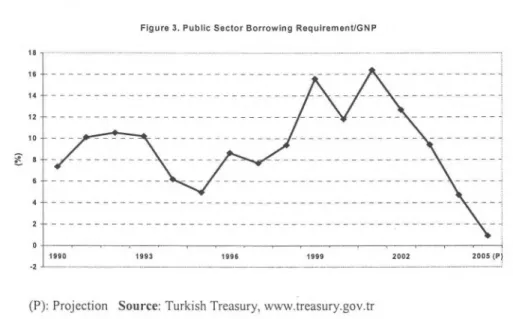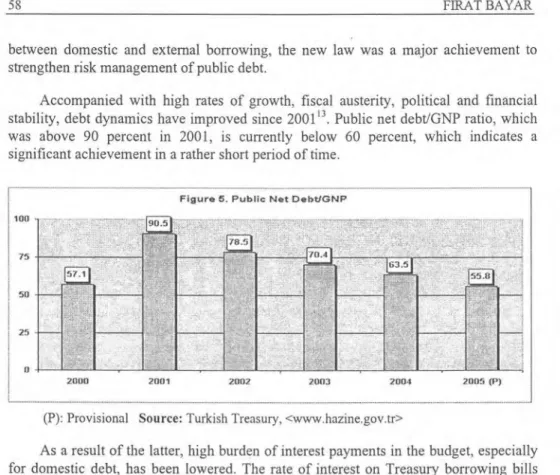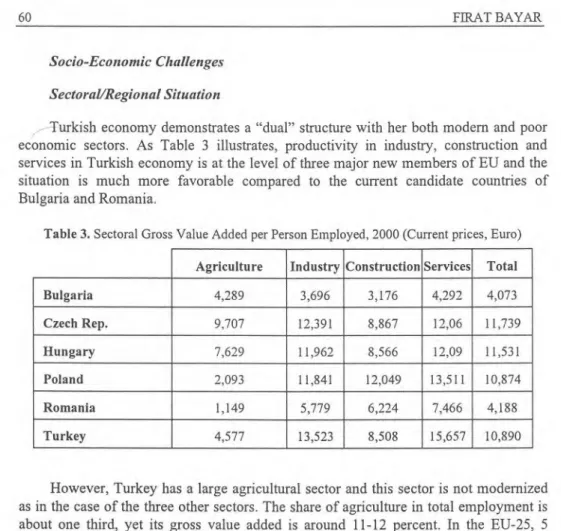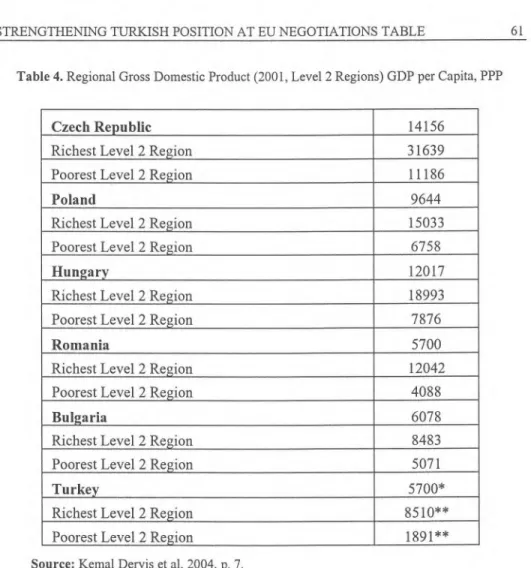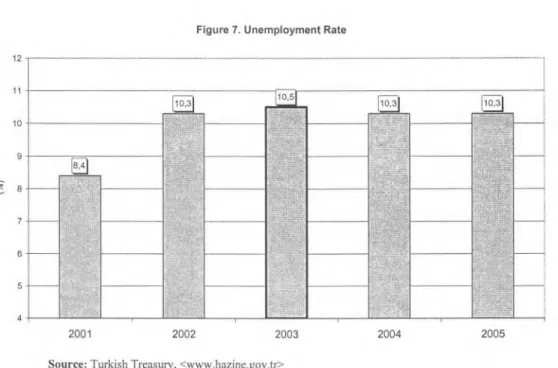STRENGTHENING TURKISH POSITION AT EU
NEGOTIATIONS TABLE: IDENTIFYING AND
ADDRESSING IN ADVANCE
MAJOR ECONOMIC CHALLENGES OF TURKEY*
F
ı
rat BAYAR **
ÖZET
3 Ekim 2005 tarihinde başlatılmış olan Türkiye'nin AB'ye katılım müzakereleri süresince, ekonomi alanına ilişkin konular artan bir oranda önem kazanacak ve gündeme gelecektir. Bu çerçevede Türkiye ekonomisi, AB tarafınca kapsamlı bir biçimde masaya yatırılacak ve detaylı bir incelemeden geçirilecektir. Dolayısıyla, ekonomi alanına ilişkin müzakere başlıklarının açılmasından önce, Türkiye ekonomisinin belli başlı ekonomik sorunlarının ve bu sorunlarla temel mücadele yollarının Türk tarafınca tespit edilerek bu konular üzerinde önceden çalışılmaya başlanması, müzakereler esnasında Türkiye'nin masadaki gücünü ve ağırlığını artıracak, müzakere sürecinin Türkiye açısından daha rahat bir şekilde geçmesini sağlayacaktır. Halihazırdaki çalışma, bu bağlamda toplam on sorun (beş makro-ekonomik, beş sosyo-ekonomik düzeyde olmak üzere) belirleyerek, yukarıda ifade edilmiş bulunan felsefe çerçevesinde incelemelerde bulunmaktadır.
Anahtar Kelimeler: Türkiye-Avrupa Birliği Katılım Müzakereleri, Türkiye Ekonomisi, Türkiye'nin Makro ve Sosyo-Ekonomik Sorunlar ı
ABSTRACT
Throughdut Turkey-EU accession negotiations that were commenced at 3 October 2005, the topics related to the economic sphere will gain importance and become a
An earlier version of this paper was presented at the "Europeanization and Transformation: Turkey in the port-Helsinki Era" Conference, Koç University, December 2-3, 2005
50 FIRAT BAYAR
current issue on the agenda in an accelerating fashion. In this framework, Turkish economy will be scrutinized in a comprehensive manner and examined in detail by the EU. Therefore, before the opening of accession chapters in the economic domain, it will enhance Turkey's strength and power at the negotiations table as well as facilitate the course of the negotiations process in the benefit of Turkey to identify and address in advance major economic challenges of the Turkish economy. By identifying ten challenges in total (fıve at macro-economic and five at socio-economic levels), the current study conducts investigations in the context of the aforementioned philosophy.
Key Words: Turkey-European Union accession negotiations, Turkish economy, macro and socio-economic challenges of Turkey.
Int roduction
Recent debates on Turkey-European Union (EU) relations have mainly focused on the inception of accession negotiations of the former. Due to the fact that commencement of those negotiations has been conditioned on the fulfillment of the political section of the Copenhagen criteria, the agenda has been rather focused on the political domain.
In that context, in the early focus of EU on Turkey, the economic section of Copenhagen criteria has not been an immediate concern. This could be partially due to the actual division of labor in Turkey between the IMF and EU, the former taking care of the economic sphere within the context of the ongoing economic program and the latter more actively focusing on the political domain.' Another reason for this situation might be stemming from the fact that Turkey had already shown progress in economic convergence with EU as part of her post-1980 liberalization policies, adoption of IMF/World Bank conditionality since mid-1990s and the Customs Union between the two parties that came into effect from 1996 onwards. 2
Formal opening of accession negotiations on October 3 1-d 2005 meant that Turkey had already fulfılled the above-mentioned political section of Copenhagen criteria. Obviously, that is not equivalent to argue that political domain will be completely out of agenda during the negotiations period. However, once we attempt to conduct a forward-looking analysis on the pace of accession negotiations of Turkey to EU, we need to take more and more into consideration the prominent role to be played by the economic sphere in the future.
Caner Bakır and Ziya Öniş, Turkey's Political Economy in the Age of Financial Globalization: The Significance of the EU Anchor, paper prepared for "Europeanization and
Transformation: Turkey in the Post-Helsinki Era", Koç University, Istanbul, 2-3 December,
2005, s. 10.
2 Mehmet Uğur, "Europeanization of Turkish Economic Policy: The Advantages of Tying One's Hands", paper prepared for "Europeanization and Transformation: Turkey in the Post-Helsinki Era", Koç University, Istanbul, 2-3 December, 2005, p. 1.
In other words, fulfilling economic section of Copenhagen criteria, namely the existence of a functioning market economy and the capacity to cope with competitive pressure and market forces within the Union, will appear as important challenges in front of Turkey to satisfy towards the goal of accession at the end of the negotiations period. EU's hand in economic affairs during negotiations will be powerful and it will exert significant pressure on Turkey to comply with its demands. Moreover, EU will most probably remain as the single core external anchor in Turkish economy with the expiry of the IMF program by 2008.
In that context, the latest Regular Report of EU on Turkey says that: "As regards the economic criteria, Turkey can be regarded as a functioning market economy, as long as it fırmly maintains its recent stabilization and reform achievements. Turkey should also be able to cope with competitive pressure and market forces within the Union in the medium term, provided that it fırmly maintains its stabilization policy and takes further decisive steps towards structural reforms". 3
The key word in this quotation is "stabilization". In other words, in order to be able to satisfy the membership economic criteria, Turkey needs to preserve her hard-won economic stability in the post-2001 era and beyond mere maintenance, this economic stabilization should further be sustained with additional step and initiatives.
On that basis, the main objective of this paper is to identify and address major economic challenges that Turkey could probably come across during the accession negotiations towards achieving this goal of stabilization. The paper argues that, in order to be able to go through a smooth and successful negotiations period, first of all these challenges need to be identified in advance and then alternative ways should be figured out for the resolution of these challenges. Taking such preliminary measures and precautionary actions beforehand will signifıcantly strengthen the Turkish position and leverage on the negotiations table. The paper aims to open the floor to discussion in that respect.
Obviously, based on the parameters of Copenhagen economic criteria, it is possible to identify many potential challenges. As Barysch mentions, EU will come up with a lot of demands on Turkey and get involved in many topics from banking sector liberalization to education policy. 4
However, due to the breadth of the topic and to ensure coherence throughout the study, two major areas of economic challenges are selected in this paper before Turkey during accession negotiations. These are the macroeconomic and socioeconomic challenges, both of which are comprised of five sub-sections, shown at Table 1 below.
3 European Commission, Issues Arising from Turkey's Membership Perspective, Commission
Staff Working Document, Brussels, 6 October 2004, p. 54
4 K. Barysch, The Economics of Turkish Accession, Centre for European Reform Essays,
52 FIRAT BAYAR
Table 1. Major Economic Challenges During Accession Negotiations
Macroeconomic Challenges Socio-Economic Challenges
Relative income and growth Sectoral/Regional situation
Inflation Unemployment
Fiscal discipline Public investment and FDI Debt sustainability Education/Health/Social security Current account balance Governance and regulatory reform
On that basis, the paper is composed of two sections, dealing with these two areas, respectively. The last section is comprised of several concluding remarks.
To emphasize once again, this list of challenges could be presented in a much more different way. Yet, the scope of this study restricts itself only with these ten topics and reserves the rest to discuss in separate papers.
Macroeconomic Challenges
Relative Income and Growth
Turkey is relatively poor in per capita terms when compared to EU-25. Table 2 below shows that Turkey has a purchasing power standards adjusted per capita income at 31 percent of the EU-25 average. However, once compared with the two acceding countries of the Union, Bulgaria and Romania, Turkey has nearly the same level of per capita income.
Table 2 Turkey's Relative Income Position in per capita GDP
(Purchasing Power Standards, 2005; EU-25=100)
EU 25 100 Euro Area 106 Poland 50 Bulgaria 32 Romania 35 Turkey 31
In addition to that, it should also be kept in mind that the figures in this comparison are a reflection of these acceding countries almost at the time of their accession, yet probably about one decade before Turkey's actual membership in the Union. Therefore, a fairer analysis would be to take the figures of these acceding countries at the time when they started negotiations and compare these with that of Turkey's for 2005, the year that formal accession negotiations started. This argument is valid in the case of new member countries, as well. For instance, GDP of Poland in
1995 was around 35 percent of the EU average in purchasing power standards.
As we had discussed earlier s, there is another reason to be optimistic at that point. These relatively low per capita income figures of Turkey have partially resulted from her low labor market participation rates and Turkey is currently in the midst of a so-called "demographic transition", referring to a rapid decline in her population growth rate. This is materialized along with a rising proportion of the 15-64 age group (which forms the potential employment group), as fewer are born to fili the below 15 group and life expectation is not still much powerful to increase the population above 64. Expansion of this working age population could be turned into a significant bonus once it is accompanied by an increase in the employment level. That could eventually come out as an important factor to be able to converge with the per capita levels of EU in the Tong run.
In this context, sustaining stable rates of high growth, along with potential improvements for the above-mentioned relative income situation and additional economic parameters will be one of the major challenges that will be faced by Turkey during accession negotiations. As Öniş argues, maintenance of high rates of growth on a sustainable basis will help in overcoming the fears of mass migration from Turkey to Europe as well, which is a major problematic issue in several EU countries. 6
On that basis, we see that Turkish economy has exhibited a volatile growth record over the last three decades and as Figure 1 illustrates below, especially beginning with the late 1980s, consecutive peaks and troughs have dominated the economic activity, particularly with major downfalls during the 1994 and 2001 crises.
5 Kemal Derviş et al, "Relative Income Growth and Convergence", Turkish Policy Quarterly, Winter, 2004.
6 Ziya Öniş, Turkey's Encounters with the New Europe: Multiple Transformations, Inherent Dilemmas and the Challenges Ahead, paper prepared for presentation at the University Association for Contemporary European Studies Conference on "The European Union: Past and Future Enlargements", Zagreb, Croatia, 5-7 September, 2005, p. 22.
Figure 1. Gross National Product (GNP) Growth
10
-10
54 FIRAT BAYAR
Source: State Planning Organization, www.dpt.gov.tr
For the last four years following the crisis in 2001, Turkey has been able to achieve high rates of growth, realized as 7.9, 5.9, 9.9 and 7,6 for 2002, 2003, 2004 and 2005, respectively. The target for 2006 is set at 5 percent, which is projected as attainable by the end of the year, as well.
Therefore, the real challenge for Turkey is to sustain high rates of growth in the medium and long term. Yet, what is more important with growth is that it should be "pro-poor" as well. Pro-poor growth, defined as growth by which poor people benefıt in absolute terms 7 is the key "quality" of growth. The simple belief that growth on its own will be automatically sufficient enough to trickle down to the poor is inadequate and Turkish experience clearly proves that. Therefore, in order to accompany growth with poverty reduction, active steps need to be taken to extend growth to all segments of the society. This issue will be a major area of concern during the accession negotiations.
Inflation
Over the last two decades, Turkey has struggled with high and persistent inflation. The average inflation rates have been about 40 percent in early 1980s, 60-65 percent in late 1980s and early 1990s and 80 percent in late 1990s. Therefore, fight against inflation has always been in focus in the design of recent economic programs in Turkey. In that direction, one of the main goals of the economic program following the 2001 crisis was to bring inflation rate to single digits.
7 Martin Ravallion, Pro-poor Growth: A Primer, World Bank Policy Research Working Paper 3242, March, 2004, p. 2
80
70
Figure 2. Consumer Price Index (Annual Percentage Change)
68,5 60 50
'6---°,
40 30 20 10 39,0 29,7 18,3 9,3 77 0 5.0 4j) 2000 2001 2002 2003 2004 2005 2006(P) 2007(P)(P): Program Source: Turkish Treasury, <www. hazine.gov.tr >
The latter has been achieved in 2004 with a realization of 9.3 percent. Inflation rate has further declined in 2005 to 7.7 percent. Dynamics of inflation have changed as well, ensuring the irreversibility of the process. 8 Moreover, this has been achieved along with high rates of economic growth. For 2006 and 2007, the targets for inflation rate are set at 5 and 4 percent, respectively.
It is very iınportant to sustain this trend of single-digit rates of inflation in the medium and long-run. Being aware of various detrimental affects of high and persistent inflation on the general well-being of the economy, keeping inflation rates under control and attaining price stability will be one of the core challenges during accession negotiations.
Fiscal Discipline
Public deficits have been one of the fundamental causes of the imbalances in the overall macroeconomic dynamics of the country for many years. These deficits as a share of GNP have increased to around 50 percent since 1990s, mainly due to the increase in the primary deficits generated particularly by the non-budget institutions and high interest payments to public debt.
This extraordinarily high PSBR/GNP ratio played a central role in the 2001 crisis, primarily by triggering a vicious cycle of increasing deficits and rising interest rates.
8 Süreyya Serdengeçti, The Turkish Economy and the European Union, Presentation at London
School of Economics, London, 27 October, 2005, p. 5
9 Non-budget institutions are state economic enterprises (SEEs), local governments, social security institutions and extra-budgetary funds.
56 FIRAT BAYAR
Figure 3. Public Sector Borrowing Requirement/GNP
18 16 - 14 - 1990 1993 1996 1999 2002 2005 (P) 12 10 8 6 4 2 -2
(P): Projection Source: Turkish Treasury, www.treasury.gov.tr
As Figure 3 above illustrates, PSBR/GNP ratio peaked at 2001, the year of the crisis, to a level of 16.4 percent, basicly due to the inherent contingent liabilities of the banking sector that put a huge burden on Treasury.
Since then, this ratio has fallen drastically and the program target for 2006 is set slightly below 0 percent, which manifests a major achievement. Strong fiscal stance and discipline has been the major factors behind this achievement.
The latter is well evidenced by high levels of public sector primary surplus, illustrated at Figure 4 below.
Figure 4. Public Sector Primary Balance/GNP, Turkey
1993-20132 2003 2004 2005(P) 2006(P)
Strong fiscal discipline needs to be continued during accession negotiations for the well-being of the fiscal stance. This is a core requirement for Turkey to satisfy the Copenhagen economic criteria of membership as well as her one-step further prospective membership of the Economic and Monetary Union, in terms of satisfying the respective Maastricht criteria of government balance. 1°
Debt Sustainability
Conducive to the financial liberalization in 1989, a tendency has come into being in the policies of governments towards financing public defıcits by domestic borrowing. This symbolized an important shift in policy as direct borrowing of the public sector from the external world was replaced by indirect borrowing from abroad via domestic agents, as the domestic agents have started to borrow from international markets themselves. 11
Obviously the direct outcome of this shift was the unprecedented rise of the securitized debt stock, which was mainly tied to domestic resources. The main characteristic of this debt stock was its short maturity, which resulted in a trap of rolling of debt characterized by Ponzi financing. This process damaged income distribution as the rise in interest payments meant an unjust income transfer away from wage earners to domestic rentiers . 12
In that framework, the most important distortion that emerged in the aftermath of the 2001 crisis was mainly due to the sharp hike in the non-cash component of domestic debt, particularly as a result of the huge burden of the insolvent state and Saving Deposit Insurance Fund (SDIF) banks on the Treasury. Therefore, debt sustainability has been an issue on the top of the agenda since 2001.
In that regard, the government has enacted the new Law on Debt Management in 2002. By bringing a strengthened, unified and permanent legal framework to the subject with clear and transparent limits to state debt, enabling efficient management of contingent liabilities with overt guarantee limits and ensuring the vital coordination
ıo The government balance section of the Maastricht criteria of Economic and Monetary Union requires that the ratio of the annual government deficit to gross domestic product (GDP) cannot exceed 3% at the end of the preceding financial year.
Nurhan Yentürk, "Short-Term Capital Inflows and Their Impact on the Macroeconomic Structure: Turkey in the 1990s", The Developing Economies, Vol. 37, March 1999, p. 99.
14
Ahmet H. Köse and Erinç Yeldan, "Turkish Economy in the 1990s: An Assessment of Fiscal Policies, Labor Markets and Foreign Trade", New Perspectives on Turkey, 18, 51-78, 1998, p.62-63.
15
GDP growth, real exchange rate, real interest rate and primary surplus are the four determinants of debt dynamics. The basic debt dynamics equation is d = - p + (r — g) D, where d is the rate of growth of the debt to GDP ratio, p is the primary surplus, r is the real rate of interest (adjusted for real exchange rate changes), g is the rate of GDP growth and D is the ratio of the stock of net debt to GDP.
70.4
63.5
57.1
58 FIRAT BAYAR
between domestic and extemal borrowing, the new law was a major achievement to strengthen risk management of public debt.
Accompanied with high rates of growth, fıscal austerity, political and financial stability, debt dynamics have improved since 2001 13 . Public net debt/GNP ratio, which was above 90 percent in 2001, is currently below 60 percent, which indicates a signifıcant achievement in a rather short period of time.
Figure 5. Public Net DebtJORIP
100 -
2000 2001 2002 2003 2004 2005 (P
75
50
2
(P): Provisional Source: Turkish Treasury, <www.hazine.gov.tr >
As a result of the latter, high burden of interest payments in the budget, especially for domestic debt, has been lowered. The rate of interest on Treasury borrowing bills had skyrocketed to around 190 percent at the peak of the crisis. Today, the annual average compound interest rates are around 16 percent, and the ratio of interest payments to GNP is about 9,5 percent (that ratio was 23 percent in 2001). Accompanying that, the maturities of lending have significantly lengthened as well.
During accession negotiations, this "debt issue" of Turkey will be on the tatile. Therefore, Turkey is obliged to further decrease its debt stock and just like in the case of government deficit mentioned above, this will be a major achievement for her to be able to comply with the relevant Maastricht criteria 14 as well.
Current Account Balance
For the last four years since the 2001 crisis, gross reserves of Central Bank have been strengthening. Currently, these reserves are nearly 60 billion US dollars, which has naturally a comforting effect on the balance of payments dynamics.
14
The government debt section of the Maastricht criteria of Economic and Monetary Union requires that the ratio of gross government debt to GDP must not exceed 60% at the end of the preceding financial year.
Figure 6. Current Account Balance (% of GDP)
-0,7
2001 2003 2005
,3
-6,4
Source: Turkish Treasury, <www.hazine.gov.tr >; IMF World Economic Outlook, September 2005.
However, as Figure 6 above illustrates, current account deficit has continuously widened during the same period. The primary reason for this development is the sharp opening of the trade deficit as a result of the increase in imports. Even though the level of exports has been increasing, the increase in imports is relatively higher and real appreciation of Turkish currency is further deteriorating this situation along with soaring world oil prices that have become chronic in recent years.
In addition to that, short-term capital flows constitute a significant portion in the financing of this deficit, which means that the economy is still vulnerable to a potential capital outflow and exchange rate depreciation.
To tackle the rising current account deficit, the government is taking measures to curb domestic demand for imports such as scaling back tax incentives for foreign goods, increasing levies on consumer credits and rising consumer credit lending rates. However, it is obvious that more structural precautions need to be taken to address this problem and this issue will most probably take place in the center of discussions during accession negotiations.
60 FIRAT BAYAR
Socio-Economic Challenges Sectoral/Regional Situation
Turkish economy demonstrates a "dual" structure with her both modern and poor economic sectors. As Table 3 illustrates, productivity in industry, construction and services in Turkish economy is at the level of three major new members of EU and the situation is much more favorable compared to the current candidate countries of Bulgaria and Romania.
Table 3. Sectoral Gross Value Added per Person Employed, 2000 (Current prices, Euro) Agriculture Industry Construction Services Total
Bulgaria 4,289 3,696 3,176 4,292 4,073 Czech Rep. 9,707 12,391 8,867 12,06 11,739 Hungary 7,629 11,962 8,566 12,09 11,531 Poland 2,093 11,841 12,049 13,511 10,874 Romania 1,149 5,779 6,224 7,466 4,188 Turkey 4,577 13,523 8,508 15,657 10,890
However, Turkey has a large agricultural sector and this sector is not modernized as in the case of the three other sectors. The share of agriculture in total employment is about one third, yet its gross value added is around 11-12 percent. In the EU-25, 5 percent of labor force in agriculture generates 2.2 percent of total value added. 15 That is the main factor in lowering total labor productivity of Turkish economy.
Turkey needs to continue with its agricultural reform project, initiated in the aftermath of the crisis in 2001. The sector needs to be transformed into a more competitive character to be able to eliminate the above-mentioned sectoral imbalance. This will be the essence of the debate during accession negotiations in order for Turkey to be able to participate in the EU common agricultural policy and benefit from EU funds.
Along with this sectoral imbalance, regional disparities are posing a greater challenge for the overall well being of Turkish economy. As seen in Table 4 below, compared to the three new member and two candidate countries of EU, the situation is relatively worse in Turkey. The richest level 2 region in Turkey has a per capita GDP that is more than four times of the lowest one.
15
European Commission, 2005 Regular Report on Turkey's Progress Towards Accession, Brussels, 9 November 2005, p.15.
Table 4. Regional Gross Domestic Product (2001, Level 2 Regions) GDP per Capita, PPP
Czech Republic 14156
Richest Level 2 Region 31639
Poorest Level 2 Region 11186
Poland 9644
Richest Level 2 Region 15033
Poorest Level 2 Region 6758
Hungary 12017
Richest Level 2 Region 18993
Poorest Level 2 Region 7876
Romania 5700
Richest Level 2 Region 12042
Poorest Level 2 Region 4088
Bulgaria 6078
Richest Level 2 Region 8483
Poorest Level 2 Region 5071
Turkey 5700*
Richest Level 2 Region 8510**
Poorest Level 2 Region 1891**
Source: Kemal Derviş et al, 2004, p. 7.
The West-East pattern of division in terms of economic activity needs to be eliminated in the Tong term. This will be a serious concern during the accession negotiations. Turkey needs to prepare a comprehensive regional development strategy to be able to benefit from the Structural and Cohesion Funds of EU to alleviate this situation during accession negotiations. In addition to that, as European Commission argues, these funds alone will not be suffıcient for a catching-up of the EU level unless the economic policy framework is adequate and a state of macroeconomic stability prevails. 16
Unemployment
Unemployment problem constitutes a major area of concern for the Turkish economy. Unemployment rate has increased since the crisis in 2001 and stuck at slightly above 10 percent as Figure 7 demonstrates.
10,5
10,31
rz
ı
62 FIRAT BAYAR
,7 8
Figure 7. Unemployment Rate
2001 2002 2003 2004 2005
Source: Turkish Treasury, <www.hazine.gov.tr>
Furthermore, this increase in unemployment is present even though Turkey has been experiencing high rates of growth for the last four years. This "growth without employment" phenomenon is clearly shown in Figure 8 below.
Figure 8. Growth without Employment and Increasing
Productivity in Manufacturing 115 110 c, 105 100 95 crı cr> 1.- 90 85 80 1997 2000 2003
—*—Number of Working People —Il—Manufacturing Value Added
Turkey has a young population and her total population is growing at about 1.5 percent per year. This means that the economy needs to create 500,000-800,000 jobs every year to be able to keep unemployment at current leve1. 17
Table 5. Unemployment Rates, 2004
Spain 11 Greece 10,5 Turkey 10,3 France 9,6 Germany 10,3 Finland 8,8 Italy 8 Poland 19 Lithuania 11,4 Slovakia 18,2 Belgium 8,4
Source: TURKSTAT, <www.tuik.gov.tr ; EUROSTAT, Candidate Countries in 2004>, 3/2005, <www.epp.eurostat.ec.europa.eu >.
As Table 5 above illustrates, unemployment is a serious problem all over Europe. Yet, what is a real problem for Turkey is that employment rate is extremely low compared to European countries. As Barysch argues, "unpaid family work" is counted as employment in Turkey and once that is removed, it would be only 20-25 percent of the working age population who has a full time-salaried job. Besides, most women do not take part in the formal labor market and female employment is the lowest in Europe with 25 percent. 18
Reversing this situation will be a major challenge during accession negotiations. New jobs should be created for the unemployed. Besides, the transition from informal to forma! employment will not be easy and require overwhelming effort.
17 Barysch, 2005, p. 6. 18 Barysch, 2005, p. 5.
64 FIRAT BAYAR
Public Investment and FDI
There has been a drastic cut in public investments as a share of GDP following the 1994 crisis. The subsequent recovery in the second half of 1990s was once more broken with the crisis in 2001.
Such a low level of investment is not sustainable and needs to be increased. This is particularly obligatory in the case of growth-friendly sectors such as education, health and basic infrastructure.
As we had argued before I9, at that point, the "quality" of fiscal policy gets into the picture as a major factor, referring to the fact that fiscal adjustment should not be made at the expense of public investment that is needed to break key bottlenecks or provide public goods to promote growth. In that context, the above-mentioned 6.5 percent primary surplus is a maximum by would standards and cannot be continued for a long period of time. Provided that debt indicators continue to evolve in a favorable way and current account deficit begins narrowing, a viable option would be to relax and reduce this amount in a gradual manner in favor of growth-promoting sectors, identified above. A lower amount of primary surplus could be compensated by such an increase in investment to promote growth in the debt equation and thereby will not deteriorate debt dynamics. Obviously, if such a relaxation is done for pure public consumption, that option will hamper the fiscal discipline.
In addition to the situation in public investments, another important issue for Turkey is to be able to attract increasing levels of foreign direct investment (FDI). As Turkey has diffıculty in generating substantial amount of domestic savings to finance the investment needed to keep high growth rates, it is an appropriate and healthy alternative to finance the current account deficit by FDI. FDI inflows are advantageous compared to other capital inflows as they cannot be repatriated at short notice and thereby do not have the potential for crises triggered from short-term flows. Moreover, they might sometimes have a stronger productivity enhancing effect than domestic investment through bringing capital, technology, expertise and know-how.
However, Turkey has not been a center of attraction for FDI, compared to other emerging market economies, mainly due to lack of political and macroeconomic stability and bureaucratic barriers in front of establishing business.
19
Kemal Derviş et al., Stabilising Stabilisation, EU-Turkey Working Papers No.7, Centre for European Policy Studies, Brussels, Belgium, 2004, s. 5-6.
Table 6. FDI in Turkey, Mexico and Spain, 1991-96 and 1997-2002 (US$ bil ion) 1991-1996 (annual average) 1997 1998 1999 2000 2001 2002 Turkey 0.7 0.8 0.9 0.8 1.0 3.2 1.0 Mexico 7.3 14.1 12.1 12.8 15.4 25.3 13.6 Spain 9.5 7.7 11.8 15.7 37.5 28.0 21.1
Note: Figures rounded up to nearest decimal. Source: The Elcano Royal Institute, www.realinstitutoelcano.org
In this context, the reform efforts in previous years to improve investment and business conditions in the country are promising. The new foreign direct investment law enacted in 2003 and establishment of the Coordination Committee for the Improvement of the Investment Climate (YOIICK) have been major steps in simplifying and streamlining company registration. Such initiatives need to be consolidated and enriched during accession negotiations. Together with the prospects of EU membership, this should lead to greater FDI inflows in near future which could in turn contribute to employment creation and further improvement of debt dynamics on the way for Turkey to realize her economic potential.
Education/Health/Social Security
Turkey's investment in human capital is limited. Total expenditure on education is around 3.5 percent of GDP. The situation in terms of educational achievements is weak as well, seen in the second column of Table 7 below.
Table 7. Total Expenditure on Education and Adult Population with Upper Secondary Education
Total Expenditure on Education (% of GDP, 2005)
% of Adult Population with Upper Secondary
Education (25-64 age group, 2005)
Turkey 3.51 26
Poland 5.31 50
Portugal 5.85 25
Greece 4.06 56
Hungary 5.18 75
Source: OECD in Figures 2005-Education and Training; OECD Education at a Glance-2006, <www.oecd.org >.
The core reasons of unemployment problem in Turkey are to be found in this picture. Skill deficiency is a serious problem as about 45 percent of unemployed have
66 FIRAT BAYAR
only primary school education. In the adult work force, average period of schooling is 5 years (the average for OECD is 10 years). Educational system has severe problems in terms of quality as well. Coping with these challenges necessitate additional supplementary resources.
In addition to education, several defıciencies remain in the domain of health. Life expectancy, maternal and infant mortality are below OECD averages. Besides, there are intricate problems with the efficiency of health services and institutions. The share of health expenditure is limited, as well.
Table 8. Total Expenditure on Hea th, per cent of GDP
2000 2001 2002 2003 2004
6.6 7.5 7.4 7.6 7.7
Source: OECD Health Data, June 2006, www.oecd.org
Social security system is another area of concern. Although there is a major increase in premium collections since 1995, the budgetary transfers to social security institutions are continuously increasing which notes a major area of vulnerability for fıscal discipline. Apart from its burden on public finance, the system necessitates a structural reformation.
In that context, the government is trying to address the problem and ensure the sustainability of the system with the new law on social security that has recently passed from the Parliament. Various steps such as unifying the social security system under a single framework and introducing a universal health insurance system are envisaged in this new law. However, these initiatives need to be complemented by additional structural steps during the negotiations period as well.
Governance and Regulatory Reform
Governance could be briefly defıned as the traditions by which the authority is exercised. In this context, a fundamental element of governance is the concept of institutions, which could be characterized as the sets of rules and norms of governance that ensures markets perform adequately with a public interest. In that sense, institutions function as one of the key determinants of economic growth and development.
In that context, institutions are closely related to the level of regulation in the economy, the latter referring to the organizational arrangements that are designed to oversee market economy, especially at the times of market failure and imperfections. Experience has proven that insuffıcient regulation and supervision over economic activity come out as the basic factors in triggering fınancial crises upon financial liberalization in developing countries.
The Turkish case is a well-suiting sample for the latter argument. One of the fundamental symptoms to deduce from the account of Turkish economy in the 1980s is the characterization of "premature liberalization and incomplete stabilization" 20 . In other words, the experience of full liberalization without fully setting up the required institutional infrastructure of strong regulatory bodies in advance placed Turkish economy prone to macroeconomic instability.
Negative outcomes of this defıciency have prevailed over the last two decades. In that context, even though the crisis in 2001 severely deteriorated Turkish economy, it also created a unique environment and opportunity to address this problem. On that basis, one of the main pillars of the economic program that was initiated in 2001 has been to prioritize regulatory reform in almost all sectors of the economy. Among these could be cited the adoption of new laws for telecommunication, sugar, tobacco, natural gas, electricity and banking sectors as well as debt management and public finance, public procurement, public financial management and control, foreign investment, etc.
Based on these new laws, independent regulatory agencies have been established. The basic goal in creating these bodies was to sustain competition and avoid monopolistic behavior in these sectors by a mechanism of surveillance and regulation. 21
The content and speed that these regulatory reforms have been undertaken are impressive in worldwide experience. However, there are stili much to be done, especially in the implementation phase of these laws by these bodies. As European Commission emphasizes, these reforms need to be further consolidated and aligned with EU standards in the medium term 22 and this will most probably be in the center of debate during accession negotiations. EU provides an invaluable anchor to sustain these reforms in the Tong run and that opportunity should be benefited in the fullest sense.
Conclusion
Economic matters will increasingly be on the agenda during the accession negotiations of Turkey to EU. Fulfilling the economic section of Copenhagen criteria, namely the existence of a functioning market economy and the capacity to cope with competitive pressure and market forces within the Union, will appear as the overriding challenges in front of Turkey during this period.
EU will more and more concentrate on this sphere and exert significant pressure on Turkey to comply with its demands. Moreover, as stated in the introduction, EU will most probably remain as the single core external anchor on Turkish economy by 2008, as Turkey's IMF supported program will expire by then.
20 Dani Rodrik, Premature Liberalization, Incomplete Stabilization: The Özal Decade in
Turkey, NBER Working Paper Series, No. 3300, 1990. 21
State Planning Organization (SPO), The Likely Effects of Turkey's Membership Upon the EU, December 2004, p. 20.
22
68 FIRAT BAYAR
In that context, as the latest Regular Report of EU on Turkey mentions, Turkey needs to maintain its current degree of economic stability during the negotiations period and above that, should take additional steps to be able to comply with the membership economic criteria and prepare her economy to be a full member.
This process is rather lengthy and prone in itself to produce various challenges upon Turkey. This paper tried to discuss several selected challenges that Turkey could probably face during accession negotiations. First set of these challenges is related to the macroeconomic indicators, namely relative income and growth; inflation; fiscal discipline; debt sustainability; and current account balance. The other set involves socio-economic parameters such as sectoral/regional situation; unemployment; public investment and FDI; education/health/social security; and governance and regulatory reform.
The rationale in the preparation of this paper is to identify and draw attention to these selected economic challenges in advance that will most probably come up during accession negotiations and encourage all to begin preliminary studies on these issues. The latter is extremely important for Turkey's success in the negotiations period and a smooth transition to EU membership.
On that basis, the paper aims at opening the floor for further discussion with wider participation towards figuring out alternative ways to address these challenges on the way for Turkey to be a full member of the European Union.
Obviously, the list of economic challenges to be faced by Turkey during accession negotiations cannot be limited with these ten issue-areas. However, this paper restricts itself only with these ten topics and reserves the rest to discuss in further studies, upon which the entire picture could be materialized.
